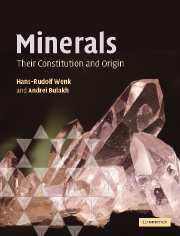Book contents
- Frontmatter
- Contents
- Preface
- Acknowledgments
- Figure credits
- Part I Structural features of minerals
- Part II Physical investigation of minerals
- Part III Variety of minerals and mineral-forming processes
- Part IV A systematic look at mineral groups
- 19 Important information about silica materials and feldspars
- 20 Simple compounds. Unusual mineral occurrences
- 21 Halides. Evaporite deposits
- 22 Carbonates and other minerals with triangular anion groups. Sedimentary origins
- 23 Phosphates, sulfates, and related minerals. Apatite as a biogenic mineral
- 24 Sulfides and related minerals. Hydrothermal processes
- 25 Oxides and hydroxides. Review of ionic crystals
- 26 Orthosilicates and ring silicates. Metamorphic mineral assemblages
- 27 Sheet silicates. Weathering of silicate rocks
- 28 Chain silicates. Discussion of some igneous and metamorphic processes
- 29 Framework silicates. Zeolites and ion exchange properties of minerals
- Part V Applied mineralogy
- Appendices
- Glossary
- References
- Index
- Plate section
- References
19 - Important information about silica materials and feldspars
from Part IV - A systematic look at mineral groups
- Frontmatter
- Contents
- Preface
- Acknowledgments
- Figure credits
- Part I Structural features of minerals
- Part II Physical investigation of minerals
- Part III Variety of minerals and mineral-forming processes
- Part IV A systematic look at mineral groups
- 19 Important information about silica materials and feldspars
- 20 Simple compounds. Unusual mineral occurrences
- 21 Halides. Evaporite deposits
- 22 Carbonates and other minerals with triangular anion groups. Sedimentary origins
- 23 Phosphates, sulfates, and related minerals. Apatite as a biogenic mineral
- 24 Sulfides and related minerals. Hydrothermal processes
- 25 Oxides and hydroxides. Review of ionic crystals
- 26 Orthosilicates and ring silicates. Metamorphic mineral assemblages
- 27 Sheet silicates. Weathering of silicate rocks
- 28 Chain silicates. Discussion of some igneous and metamorphic processes
- 29 Framework silicates. Zeolites and ion exchange properties of minerals
- Part V Applied mineralogy
- Appendices
- Glossary
- References
- Index
- Plate section
- References
Summary
Introduction
We begin our discussion of specific mineral classes with the two most common constituents of the earth's crust: quartz and feldspar. From a genetic point of view such a priority is justified. They are present in most rocks and, without knowledge of them, it is difficult to discuss igneous, metamorphic, and sedimentary mineral-forming processes. It is true that quartz, and particularly feldspars, display some of the most complex crystal structures, the details of some of which are not yet understood. In this context we will not dwell on intricate details but use silica minerals and feldspar to illustrate the principles of phase transformations and polymorphism that were introduced in earlier chapters. After a discussion of the minerals we will show how they form in granite and highlight some of the features of this rock of which much of the continental crust is composed.
Silica minerals
The silica minerals, with an overall composition SiO2, include many polymorphs (Table 19.1). Quartz is the most common member, occurring both in a trigonal low-temperature form (α-quartz) and a hexagonal high-temperature form (β-quartz). Other important silica polymorphs are α- and β-tridymite, α- and β-cristobalite, coesite, and stishovite. Opal is a solid silica gel containing a large amount of water. The stability fields of some silica polymorphs are shown in Figure 19.1.
- Type
- Chapter
- Information
- MineralsTheir Constitution and Origin, pp. 313 - 336Publisher: Cambridge University PressPrint publication year: 2004



